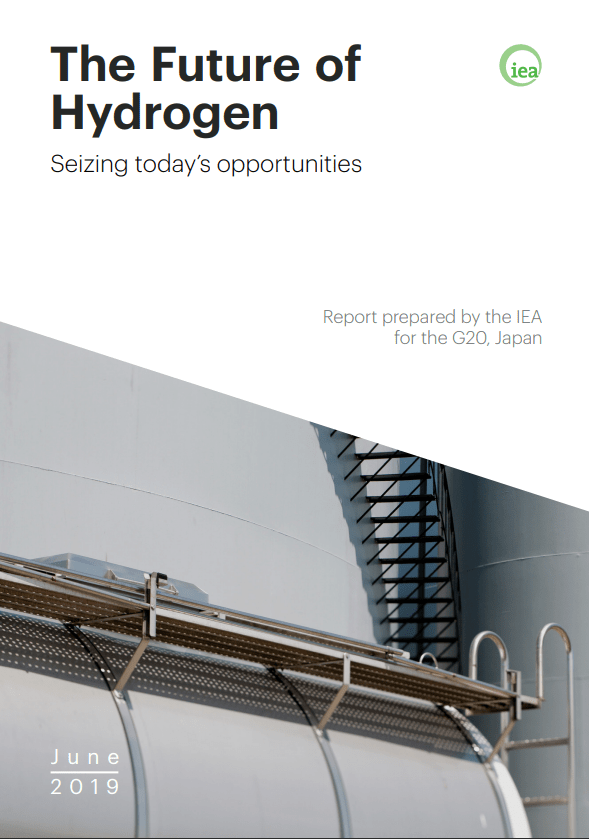
The Future of Hydrogen
Executive summary
The time is right to tap into hydrogen’s potential to play a key role in a clean, secure and affordable energy future. At the request of the government of Japan under its G20 presidency, the International Energy Agency (IEA) has produced this landmark report to analyse the current state of play for hydrogen and to offer guidance on its future development. The report finds that clean hydrogen is currently enjoying unprecedented political and business momentum, with the number of policies and projects around the world expanding rapidly. It concludes that now is the time to scale up technologies and bring down costs to allow hydrogen to become widely used. The pragmatic and actionable recommendations to governments and industry that are provided will make it possible to take full advantage of this increasing momentum.
Hydrogen can help tackle various critical energy challenges. It offers ways to decarbonise a range of sectors – including long-haul transport, chemicals, and iron and steel – where it is proving difficult to meaningfully reduce emissions. It can also help improve air quality and strengthen energy security. Despite very ambitious international climate goals, global energy-related CO2 emissions reached an all time high in 2018. Outdoor air pollution also remains a pressing problem, with around 3 million people dying prematurely each year.
Hydrogen is versatile. Technologies already available today enable hydrogen to produce, store, move and use energy in different ways. A wide variety of fuels are able to produce hydrogen, including renewables, nuclear, natural gas, coal and oil. It can be transported as a gas by pipelines or in liquid form by ships, much like liquefied natural gas (LNG). It can be transformed into electricity and methane to power homes and feed industry, and into fuels for cars, trucks, ships and planes.
Hydrogen can enable renewables to provide an even greater contribution. It has the potential to help with variable output from renewables, like solar photovoltaics (PV) and wind, whose availability is not always well matched with demand. Hydrogen is one of the leading options for storing energy from renewables and looks promising to be a lowest-cost option for storing electricity over days, weeks or even months. Hydrogen and hydrogenbased fuels can transport energy from renewables over long distances – from regions with abundant solar and wind resources, such as Australia or Latin America, to energy-hungry cities thousands of kilometres away.
There have been false starts for hydrogen in the past; this time could be different. The recent successes of solar PV, wind, batteries and electric vehicles have shown that policy and technology innovation have the power to build global clean energy industries. With a global energy sector in flux, the versatility of hydrogen is attracting stronger interest from a diverse group of governments and companies. Support is coming from governments that both import and export energy as well as renewable electricity suppliers, industrial gas producers, electricity and gas utilities, automakers, oil and gas companies, major engineering firms, and cities. Investments in hydrogen can help foster new technological and industrial development in economies around the world, creating skilled jobs.
Hydrogen can be used much more widely. Today, hydrogen is used mostly in oil refining and for the production of fertilisers. For it to make a significant contribution to clean energy transitions, it also needs to be adopted in sectors where it is almost completely absent at the moment, such as transport, buildings and power generation.
However, clean, widespread use of hydrogen in global energy transitions faces several challenges:
- Producing hydrogen from low-carbon energy is costly at the moment. IEA analysis finds that the cost of producing hydrogen from renewable electricity could fall 30% by 2030 as a result of declining costs of renewables and the scaling up of hydrogen production. Fuel cells, refuelling equipment and electrolysers (which produce hydrogen from electricity and water) can all benefit from mass manufacturing.
- The development of hydrogen infrastructure is slow and holding back widespread adoption. Hydrogen prices for consumers are highly dependent on how many refuelling stations there are, how often they are used and how much hydrogen is delivered per day. Tackling this is likely to require planning and coordination that brings together national and local governments, industry and investors.
- Hydrogen is almost entirely supplied from natural gas and coal today. Hydrogen is already with us at industrial scale all around the world, but its production is responsible for annual CO2 emissions equivalent to those of Indonesia and the United Kingdom combined. Harnessing this existing scale on the way to a clean energy future requires both the capture of CO2 from hydrogen production from fossil fuels and greater supplies of hydrogen from clean electricity.
- Regulations currently limit the development of a clean hydrogen industry. Government and industry must work together to ensure existing regulations are not an unnecessary barrier to investment. Trade will benefit from common international standards for the safety of transporting and storing large volumes of hydrogen and for tracing the environmental impacts of different hydrogen supplies.
The IEA has identified four near-term opportunities to boost hydrogen on the path towards its clean, widespread use. Focusing on these real-world springboards could help hydrogen achieve the necessary scale to bring down costs and reduce risks for governments and the private sector. While each opportunity has a distinct purpose, all four also mutually reinforce one another.
- Make industrial ports the nerve centres for scaling up the use of clean hydrogen. Today, much of the refining and chemicals production that uses hydrogen based on fossil fuels is already concentrated in coastal industrial zones around the world, such as the North Sea in Europe, the Gulf Coast in North America and southeastern China. Encouraging these plants to shift to cleaner hydrogen production would drive down overall costs. These large sources of hydrogen supply can also fuel ships and trucks serving the ports and power other nearby industrial facilities like steel plants.
- Build on existing infrastructure, such as millions of kilometres of natural gas pipelines. Introducing clean hydrogen to replace just 5% of the volume of countries’ natural gas supplies would significantly boost demand for hydrogen and drive down costs.
- Expand hydrogen in transport through fleets, freight and corridors. Powering highmileage cars, trucks and buses to carry passengers and goods along popular routes can make fuel-cell vehicles more competitive.
- Launch the hydrogen trade’s first international shipping routes. Lessons from the successful growth of the global LNG market can be leveraged. International hydrogen trade needs to start soon if it is to make an impact on the global energy system.
International co-operation is vital to accelerate the growth of versatile, clean hydrogen around the world. If governments work to scale up hydrogen in a co-ordinated way, it can help to spur investments in factories and infrastructure that will bring down costs and enable the sharing of knowledge and best practices. Trade in hydrogen will benefit from common international standards. As the global energy organisation that covers all fuels and all technologies, the IEA will continue to provide rigorous analysis and policy advice to support international co-operation and to conduct effective tracking of progress in the years ahead.
As a roadmap for the future, we are offering seven key recommendations to help governments, companies and others to seize this chance to enable clean hydrogen to fulfil its long-term potential.
The IEA’s 7 key recommendations to scale up hydrogen
- Establish a role for hydrogen in long-term energy strategies. National, regional and city governments can guide future expectations. Companies should also have clear long-term goals. Key sectors include refining, chemicals, iron and steel, freight and long-distance transport, buildings, and power generation and storage.
- Stimulate commercial demand for clean hydrogen. Clean hydrogen technogies are available but costs remain challenging. Policies that create sustainable markets for clean hydrogen, especially to reduce emissions from fossil fuel-based hydrogen, are needed to underpin investments by suppliers, distributors and users. By scaling up supply chains, these investments can drive cost reductions, whether from low-carbon electricity or fossil fuels with carbon capture, utilisation and storage.
- Address investment risks of first-movers. New applications for hydrogen, as well as clean hydrogen supply and infrastructure projects, stand at the riskiest point of the deployment curve. Targeted and time-limited loans, guarantees and other tools can help the private sector to invest, learn and share risks and rewards.
- Support R&D to bring down costs. Alongside cost reductions from economies of scale, R&D is crucial to lower costs and improve performance, including for fuel cells, hydrogenbased fuels and electrolysers (the technology that produces hydrogen from water). Government actions, including use of public funds, are critical in setting the research agenda, taking risks and attracting private capital for innovation.
- Eliminate unnecessary regulatory barriers and harmonise standards. Project developers face hurdles where regulations and permit requirements are unclear, unfit for new purposes, or inconsistent across sectors and countries. Sharing knowledge and harmonising standards is key, including for equipment, safety and certifying emissions from different sources. Hydrogen’s complex supply chains mean governments, companies, communities and civil society need to consult regularly.
- Engage internationally and track progress. Enhanced international co-operation is needed across the board but especially on standards, sharing of good practices and crossborder infrastructure. Hydrogen production and use need to be monitored and reported on a regular basis to keep track of progress towards long-term goals.
- Focus on four key opportunities to further increase momentum over the next decade. By building on current policies, infrastructure and skills, these mutually supportive opportunities can help to scale up infrastructure development, enhance investor confidence and lower costs:
- Make the most of existing industrial ports to turn them into hubs for lower-cost, lower-carbon hydrogen.
- Use existing gas infrastructure to spur new clean hydrogen supplies.
- Support transport fleets, freight and corridors to make fuel-cell vehicles more competitive.
Establish the first shipping routes to kick-start the international hydrogen trade.






The Future of Hydrogen 0 reviews
Login to Write Your ReviewThere are no reviews yet.